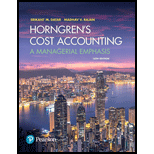
Horngren's Cost Accounting, Student Value Edition Plus MyLab Accounting with Pearson eText - Access Card Package (16th Edition)
16th Edition
ISBN: 9780134642468
Author: Srikant M. Datar, Madhav V. Rajan
Publisher: PEARSON
expand_more
expand_more
format_list_bulleted
Concept explainers
Textbook Question
Chapter 4, Problem 4.8Q
Give two reasons why most organizations use an annual period rather than a weekly or monthly period to compute budgeted indirect-cost rates.
Expert Solution & Answer
Want to see the full answer?
Check out a sample textbook solution
Students have asked these similar questions
can you please provide correct answer. @ general account
True solution wanted in this general account questions
Need solution for this general account.
Chapter 4 Solutions
Horngren's Cost Accounting, Student Value Edition Plus MyLab Accounting with Pearson eText - Access Card Package (16th Edition)
Ch. 4 - Define cost pool, cost tracing, cost allocation,...Ch. 4 - How does a job-costing system differ from a...Ch. 4 - Why might an advertising agency use job costing...Ch. 4 - Describe the seven steps in job costing.Ch. 4 - Give examples of two cost objects in companies...Ch. 4 - Describe three major source documents used in...Ch. 4 - What is the advantage of using computerized source...Ch. 4 - Give two reasons why most organizations use an...Ch. 4 - Distinguish between actual costing and normal...Ch. 4 - Describe two ways in which a house-construction...
Ch. 4 - Comment on the following statement: In a...Ch. 4 - Describe three different debit entries to the...Ch. 4 - Describe three alternative ways to dispose of...Ch. 4 - When might a company use budgeted costs rather...Ch. 4 - Prob. 4.15QCh. 4 - Which of the following does not accurately...Ch. 4 - Sturdy Manufacturing Co. assembled the following...Ch. 4 - For which of the following industries would...Ch. 4 - ABC Company uses job-order costing and has...Ch. 4 - Under Stanford Corporations job costing system,...Ch. 4 - (10 min) Job costing, process costing. In each of...Ch. 4 - Actual costing, normal costing, accounting for...Ch. 4 - Job costing, normal and actual costing. Atkinson...Ch. 4 - Budgeted manufacturing overhead rate, allocated...Ch. 4 - Job costing, accounting for manufacturing...Ch. 4 - Job costing, consulting firm. Frontier Partners, a...Ch. 4 - Time period used to compute indirect cost rates....Ch. 4 - Accounting for manufacturing overhead. Creative...Ch. 4 - Job costing, journal entries. The University of...Ch. 4 - Journal entries, T-accounts, and source documents....Ch. 4 - Job costing, journal entries. Donald Transport...Ch. 4 - Job costing, unit cost, ending work in process....Ch. 4 - Job costing; actual, normal, and variation from...Ch. 4 - Job costing; variation on actual, normal, and...Ch. 4 - Proration of overhead. The Ride-On-Wave Company...Ch. 4 - Job costing, accounting for manufacturing...Ch. 4 - Service industry, job costing, law firm. Kidman ...Ch. 4 - Service industry, job costing, two direct- and two...Ch. 4 - Proration of overhead. (Z. Iqbal, adapted) The Zaf...Ch. 4 - Normal costing, overhead allocation, working...Ch. 4 - Proration of overhead with two indirect cost...Ch. 4 - General ledger relationships, under- and...Ch. 4 - Overview of general ledger relationships. Estevez...Ch. 4 - Allocation and proration of overhead. Resource...Ch. 4 - (2530 min.) Job costing, ethics. Joseph Underwood...Ch. 4 - Job costingservice industry. Market Pulse performs...
Knowledge Booster
Learn more about
Need a deep-dive on the concept behind this application? Look no further. Learn more about this topic, accounting and related others by exploring similar questions and additional content below.Similar questions
- Need correct answer. Accountarrow_forwardAssuming actual volume is 10,000 units and planned volume is 12,000 units, the sales volume variance in units a. equals 2,000 units, unfavorable b. equals 2,000 units, favorable c. cannot be determined without additional information d. None of these answers is correct.arrow_forwardDon't use ai given answer accounting questionsarrow_forward
arrow_back_ios
SEE MORE QUESTIONS
arrow_forward_ios
Recommended textbooks for you
- Principles of Accounting Volume 2AccountingISBN:9781947172609Author:OpenStaxPublisher:OpenStax College
 Managerial Accounting: The Cornerstone of Busines...AccountingISBN:9781337115773Author:Maryanne M. Mowen, Don R. Hansen, Dan L. HeitgerPublisher:Cengage Learning
Managerial Accounting: The Cornerstone of Busines...AccountingISBN:9781337115773Author:Maryanne M. Mowen, Don R. Hansen, Dan L. HeitgerPublisher:Cengage Learning Principles of Cost AccountingAccountingISBN:9781305087408Author:Edward J. Vanderbeck, Maria R. MitchellPublisher:Cengage Learning
Principles of Cost AccountingAccountingISBN:9781305087408Author:Edward J. Vanderbeck, Maria R. MitchellPublisher:Cengage Learning  Excel Applications for Accounting PrinciplesAccountingISBN:9781111581565Author:Gaylord N. SmithPublisher:Cengage Learning
Excel Applications for Accounting PrinciplesAccountingISBN:9781111581565Author:Gaylord N. SmithPublisher:Cengage Learning

Principles of Accounting Volume 2
Accounting
ISBN:9781947172609
Author:OpenStax
Publisher:OpenStax College

Managerial Accounting: The Cornerstone of Busines...
Accounting
ISBN:9781337115773
Author:Maryanne M. Mowen, Don R. Hansen, Dan L. Heitger
Publisher:Cengage Learning

Principles of Cost Accounting
Accounting
ISBN:9781305087408
Author:Edward J. Vanderbeck, Maria R. Mitchell
Publisher:Cengage Learning

Excel Applications for Accounting Principles
Accounting
ISBN:9781111581565
Author:Gaylord N. Smith
Publisher:Cengage Learning
Responsibility Accounting| Responsibility Centers and Segments| US CMA Part 1| US CMA course; Master Budget and Responsibility Accounting-Intro to Managerial Accounting- Su. 2013-Prof. Gershberg; Author: Mera Skill; Rutgers Accounting Web;https://www.youtube.com/watch?v=SYQ4u1BP24g;License: Standard YouTube License, CC-BY